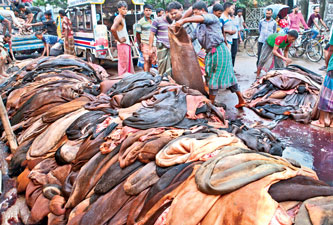Jubair Hasan and Ismail Hossain | September 16, 2016 00:00:00
 Tannery suppliers pile up rawhides at Lalbag in Old Dhaka after collecting them from traders on the Eid-day (Tuesday). — FE Photo by Shafiqul Alam
Tannery suppliers pile up rawhides at Lalbag in Old Dhaka after collecting them from traders on the Eid-day (Tuesday). — FE Photo by Shafiqul Alam
Sales of rawhides of the sacrificial animals have kicked off in the capital amid higher preservation cost triggered by soaring salt prices, prompting the seasonal traders to sell out their stocks due to fear that such skins might get rotten soon.
In the wake of skyrocketing prices of salt, an essential ingredient for preservation of hides, worries of the seasonal rawhide traders have gone up manifold due to their lack of capacity to preserve the valuable hides for long. Besides, rawhide prices have dropped down by 10 per cent in the market from the previous occasion.
While visiting the rawhide markets at Posta and Hazaribag in the city, the FE correspondents found that a good number of trucks, lorries and human-haulers, carrying skins of the sacrificial animals from various corners of the country, started reaching there.
The traders were seen busy preserving rawhides with salt and also bargaining with the merchants and the tanners over their selling prices.
Some of the seasonal traders were, at the same time, found claiming to have bought skins of sacrificial animals at prices higher than the rates set by the merchants and the tanners ahead of the Eid-ul-Azha.
When the seasonal traders approached the merchants and tanners for buying their rawhides, they refused to buy those at higher prices than the fixed rates, citing low international demand and present stockpile, according to the traders.
"I bought rawhides at Tk 60 per square-feet (sft), but the buyers denied paying beyond Tk 50. So, I don't know whether I can sale those items," said Mohammad Habib Mia, a seasonal trader.
At the same time, higher preservation cost has made the situation much more critical.
According to the traders, price of per 55-kg sack of salt currently varies from Tk 1,500 to Tk 1,600, whereas the price was just Tk 550 during the Eid festival last year.
They said around 10 kg of salt is used for preserving one cow-hide, and earlier around Tk 90 was spent per hide. But now the cost has increased to nearly Tk 200 following the current exorbitant price of salt.
Hazaribag-based trader Mohammad Entaz, who has been trading rawhides for the last 20 years, said lower prices of hides and higher preservation-cum-production cost could prompt many traders to smuggle out a large portion of their collected rawhides for getting better prices.
"The seasonal traders will be hit hard this year, as they do not have capacity to preserve hides for a long time. But we have the capacity to preserve hides even for a year," he said.
A section of seasonal traders blame syndications among the hide and skin merchants for their loss. But the merchants say that it is the wholesalers who buy rawhides from the seasonal traders and the middlemen and then process those with salt. So, there is no scope of syndication by merchants.
When contacted, Bangladesh Hide and Skin Merchants Association (BHSMA) President Haji Delwar Hossain said this year there is a possibility that a portion of rawhides might get destroyed, as the seasonal traders may use salt in a limited manner.
While the association's secretary general Md Tipu Sultan said they are buying rawhides at slightly higher prices than the fixed rates.
He said the prices of rawhides are usually set on the basis of their demand in the international market. Every year the tanners set reasonable prices for the item, so that the people can get fair prices and the traders do not incur loss.
According to BHSMA, they have collected 1.0 to 1.2 million pieces of rawhides and skins in two days of Eid-ul-Azha. Some 15 leading tanners collect rawhides directly from their agents across the country, whereas others collect through traders.
© 2024 - All Rights with The Financial Express
